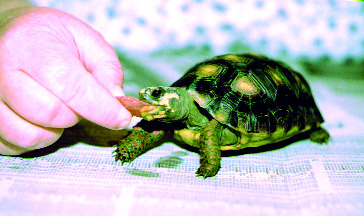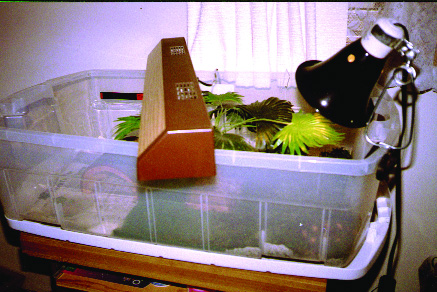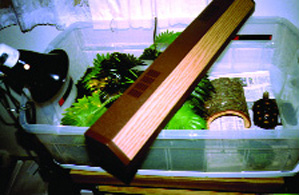
No cold feet for a baby Redfoot tortoise in Chicago

Some Indoor Housing Ideas
by Barbara Schreiber
Raising a tropical tortoise in the city of Chicago, Illinois, U.S.A., is very challenging, to say the least. Our severe winters make it impossible to keep tortoises outdoors year-round, and furnaces that operate on and off for 24 hours a day during this time of year really take a toll on indoor humidity. And even though our summers are always hot and very humid, tortoises that must live indoors are faced with low humidity, once again, due to air conditioning. As a first-time tortoise keeper, I would like to share my experiences with successfully raising a baby Red-footed tortoise (Geochelone carbonaria), named Horace, in this, often harsh, climate.
When I decided that I wanted a baby tortoise, the first thing I did was read up on the subject. This initial research was probably the most enjoyable and exciting part of preparing for my new companion. I narrowed down my choices by eliminating species whose needs I could not meet, and by focusing on those that had qualities that interested me. Species that required hibernation were also crossed off my list, since this is a technique with which I am unfamiliar. Lastly, I wanted a tortoise species with a friendly and responsive personality that would interact with me. In the end I decided upon a Red-footed tortoise (Geochelone carbonaria). I acquired my captive-raised baby Red-foot from a reptile shop in July of 2002. He was only 1.5” in length and appeared to even still have his egg tooth! My first challenge was getting Horace home comfortably, as the store clerk placed him in a brown paper bag and stapled the top closed, even though it was about 90° F that day. I quickly opened the top of the bag and left the car windows open during the ride home. As soon as Horace arrived, I soaked him in a margarine tub lid filled with room temperature water. He immediately dipped his tiny head in and took a long, deep drink.
Horace’s housing was simple—a large Rubbermaid storage container (25.5” L x 16” W x 9” H) lined with black-and-white newspaper, a clump of sphagnum moss in one corner, a margarine tub lid for his food dish, and a lid from a cake frosting can for his water dish. A thermometer at each end, humidity gauge, heat lamp, ReptiSun 5.0 UVB light, cuttlebone, artificial palm tree for shade, and hideout log for shelter completed his set-up. Two months later I covered half of the housing floor with sphagnum moss upon the advice of Horace’s veterinarian, who specializes in tortoises. About one year later, I moved him into a larger “jumbo” Rubbermaid storage container that measures 34” L x 20” W x 10” H. This housing is set-up the same way as the first, except for a larger amount of sphagnum moss, larger water and food dishes, and the removal of Horace’s hideout log after he got himself wedged in there one morning while trying to turn around inside it.

To keep up the humidity in his first habitat, I misted both the moss and newspaper (lightly) with warm water twice daily using a hand-held spray bottle. In his larger quarters I still use the spray bottle, but I mist only the moss section, which has proven to be more than adequate. On a weekly basis, I completely strip down the housing, wash it out with dish soap, rinse thoroughly, replace the newspaper, and soak the moss in a bucket of hot water. After I wring out the moss and replace it back in the housing, it is nice and warm and damp, and raises the humidity level to about 80 percent. During summer nights Horace sleeps at room temperature, with only a large towel draped halfway across the top of his enclosure to hold in the heat and humidity. It is much more challenging to maintain an adequate humidity level during the winter, however. One solution is to construct a “humidity box.” I made one for Horace last winter out of a CoolWhip tub (placed upside-down so that the top is actually the “floor”), and cut a round hole in the side, just large enough for him to enter and exit. In it I placed sphagnum moss that was soaked in hot water and rung out slightly. This winter Horace will need a larger humidity box, since he has outgrown CoolWhip tubs! To keep him warm at night in winter, I use a 50-watt ceramic heater over the moss-covered end of his housing, and cover the opposite end with a towel to hold in the humidity. To make sure he is adequately hydrated, I also soak Horace two or three times per week in warm water.

Since Horace does not have the luxury of a tortoise garden in our small backyard, feeding can also be a challenge. His staple diet consists of high-calcium greens. For variety, I offer Hibiscus flowers and leaves, and pre-packaged salad mixes, such as “Field Greens,” which contains romaine lettuce, endive, escarole, radicchio, and carrots. Weekly trips to the salad bar also provide a wide variety for Horace in the form of fruits and vegetables. Additional offerings include Walkabout Farms baby forest tortoise mix, and hay (veterinarian recommended) in the form of bottled pellets, which is great for people with allergies. Once per week, Horace is also offered a small amount of soaked Rep-Cal tortoise food, which he absolutely loves. Sprinkling his food with apple juice offers additional variety and gets him to eat items he is not particularly fond of – like most tortoises, Horace definitely has his favorite foods. I also supplement Horace’s diet with Rep-Cal multivitamins and phosphorous-free calcium with vitamin D3, which is mixed together in a saltshaker. I always try to give him a surprise each day by offering something different in his salad. Horace has a very hearty appetite and eagerly waits for me each morning in anticipation of his breakfast. On weekends he makes lots of noise by “climbing” the sides of his enclosure so that he is standing up on his hind legs and then falls down with a loud “thud.” Horace does this deliberately, it seems, to wake me up (he lives in my bedroom) so that I will get out of bed and make his salad for him!
For exercise, which is always supervised, Horace has the run of our small backyard during warm summer days.
Unfortunately, due to predators of the human kind, Horace cannot be left to live outdoors all summer. When he was smaller, one of his playful antics included climbing up on top of his hideout log and sliding down the other side. Horace responds to his name (although the vet thinks he may be female), stretches his neck up as far as he can in order to be petted on top of his little head, and readily eats from my hand. Because he is so responsive and friendly to everyone in our family, Horace can easily be considered a “family pet.”
Future plans for Horace’s habitat as he grows to adult size include an industrial-sized plastic tub filled with sphagnum moss and furnished basically the same way as he is set-up now. For humidity, I have purchased an automatic mister that will cover the larger area more adequately, and may even add a waterfall-type water dish. I prefer plastic tubs for tortoises that require high humidity because they are easy to wash and keep clean, and also because wood tends to become moldy. Horace is now about one-and-a-half years old, and his recent trip to the veterinarian confirmed that he is in excellent health, has normal shell growth, and is parasite-free. Horace seems to be well on his way to living a long, healthy life, and I hope to enjoy his companionship for many years to come.